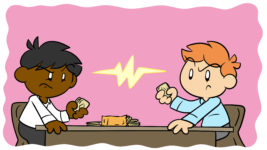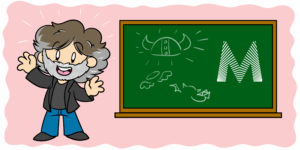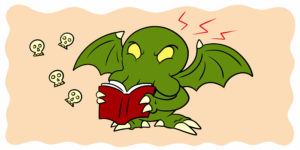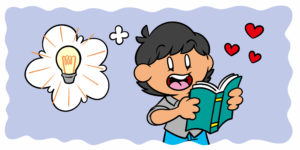Setting out to write a short story is a difficult task. While some may view them as an easy medium, anyone with experience writing short stories knows that a shorter length doesn’t mean reduced complexity.
In this article, I’ll be exploring some of the demands short fiction makes of an author and using examples from accomplished writers to show that when you embrace those challenges, you can write something amazing.
The difference between short stories and stories that aren’t very long
‘Short story’ is a bit of a misnomer, making it sound like word count is the defining factor. Like poetry, short stories use many of the same tools as longer fiction but are an art form in their own right. Simply writing something that’s a few thousand words won’t do: short stories are precision crafted works of fiction that use their brevity as a narrative device.
If you’ve written something that won’t quite fill a novel, then expand on your story or develop your characters. Don’t think you can get away with calling it a short story.
Should you expand your story?
A short story is a narrative at its best when told at less than novel length, the kind of story where extreme brevity heightens the reader’s experience. Short stories falter when expanded into longer fiction, just as longer fiction seems lacking when cut down into a shorter format.
Ian McEwan’s novel Enduring Love is expanded from a short story and shouldn’t have been. The engrossing first chapter, about a balloon accident, stands as a strong short story but what follows is lackluster and plodding. This is an example of the siren song short stories can have for authors. When they work they’re beguiling, weaving a spell over the reader that leaves them desperate for more, but that doesn’t necessarily mean there’s more to give.
On the other hand is Chuck Palahniuk’s Fight Club, which began life as a short story based on the rules and reasoning behind the club’s creation (eventually the book’s sixth chapter).
Palahniuk’s short story hinted at a far broader philosophy. For the expansion to longer fiction, Palahniuk asks ‘who invented this philosophy, who needs it, and how does it play out?’ and the story unfolds naturally. Enduring Love throws its characters into a horrible situation, a once in a lifetime experience, that supports a single chapter brilliantly. But after that point McEwan has to add the further device of one character’s obsession with another to continue the story.
To write a great short story you have to ensure that a short story is the best form for your narrative. It may be where it starts but if a larger story presents itself then don’t be restricted by what you ‘meant’ to write. Equally important is understanding when you just want there to be a larger story.
It’s helpful to think of short stories as short-term relationships. They’re passionate and no less important for their brevity, but turn into disasters if you drag them out past their natural length. Short stories are intense, focused experiences. Seek to instill the desire for more in your reader, but don’t get sucked into that desire yourself.
Use your limitations
So what is it that short stories do so well?
Of course there’s the usual answer of entertainment and intellectual stimulation, but the area in which short stories specialize is creating microcosms.
Microcosms are tiny examples that give insight into a greater whole. Of course fiction is made up of microcosms, the situations of almost every character offer a microcosmic view of the human condition, but short fiction typically deals with a single microcosm.
One of the most famous short stories in literature, usually attributed to Ernest Hemingway, is only six words long:
For sale: baby shoes, never worn.
These six simple words offer a microcosmic view of the experience of the seller. A tiny corner of this unseen character’s experience is presented but the reader’s attention is drawn to so much more. Grief is never mentioned and yet the scale of its implication is staggering. It’s not just that more information isn’t needed; it would actively lessen the impact.
The power of the short story is that it has a license to choose a single microcosm and explore it thoroughly. Novels have a wider variety of responsibilities, there is the expectation of multiple moments building to a conclusion, but in divesting itself of these the short story has the ability to be all punch. An explosion of insight and emotion with no further responsibility to plot.
The difference between short stories and stories which just aren’t very long is this relationship with the microcosm. Short stories get one, two at a push, three at the push of a genius, whereas novels have to keep stacking them up while building character and setting, and progressing the narrative.
The secret to a great short story is in understanding that this limitation is freeing rather than confining. The responsibilities you no longer have to honor are far more numerous than the limitations placed on your writing. Writing a short story allows you to focus on your microcosm at the expense of all else, but first you have to decide what it’s going to be.
Choosing your microcosm
Your microcosms can be anything: a character, an emotion, a place. You have free reign to choose anything simply based on its value as a metaphor. Unlike longer fiction the reader isn’t asking ‘where is this going?’ They understand that you have brought them to a place because there is something to see, and have accepted that as enough reason to come.
Julio Cortázar’s Axolotl is a brilliant story in which a single character stares at a tank of axolotls. In hypnotic fashion the writer slowly changes places with one of the creatures, until he watches it walk away in his body:
There was a time when I thought a great deal about the axolotls. I went to see them in the aquarium at the Jardin des Plantes and stayed for hours watching them, observing their immobility, their faint movements. Now I am an axolotl.
The experience is a microcosmic commentary on fascination, nature, human consciousness and more. There is no justification needed for why this character or this moment has been chosen because it works as a short story.
When choosing your microcosm ask if it’s worthy of the amount of time you’re asking from the reader. Is it the best microcosm for the point you’re trying to make? When you’re free to choose anything then it really should be.
Staying in one place
It’s easy to say that short stories are limited and to issue the edict ‘stay in one place / with one person / in one time’. There’s a lot of truth to that – the more you vary the different elements of your story the less effective it will be – but that’s only because this kind of variety detracts from an intense examination of one or two microcosms. Axolotl doesn’t work because it stays in one place, in one moment, with one character. It stays where it starts because everything it needs is there. The character’s emotional journey is the microcosm, and Cortázar never takes his eye off the ball.
Neil Gaiman’s Troll Bridge details three meetings between a young boy and a troll. Every few years the protagonist must persuade the troll not to eat his life. Though the reader is only present for these meetings they witness the boy change over his life. He goes from an endearing child, to a teenager willing to sacrifice an innocent for his own life, to a bitter adult who can no longer argue that he is using his life better than the troll will.
Gaiman could follow the protagonist away from these meetings, tell the reader what happens to him in the meantime, but it’s unnecessary. The characters are all that change, and with the reader’s attention focused, the subtlest tones, actions and omissions show how the main character has changed for the worse. The protagonist reflects late in the story that he hasn’t mentioned his wife and the reader realizes how loveless he has become. When the troll takes his life the tragedy isn’t that it’s gone, it’s that it was wasted while he had it:
I thought that Eleanora – that was my wife’s name; I should have mentioned that before, I suppose – didn’t know about the other woman; but I got back from a two-week jaunt to New York one winter’s day, and when I arrived at the house it was empty and cold.
Staying in one place doesn’t guarantee a great short story, but if you’re focusing all your efforts on exploring one microcosm then that’s where any change should occur.
Craft
Sticking with your chosen microcosm can be difficult, but the more focused you remain on that core idea the better your short story will be. It can be difficult for writers experienced in other styles to shed the expectations of long fiction.
Remember: usually the reader needs who, what, why, how and when. For a short story that’ll change your reader’s life you need to absolutely nail one of these and forget all the others.
Thankfully the tools you need for this kind of focus can be cannibalized from longer fiction writing. Try Are you killing your book with too much detail and explanation? for advice on cutting out superfluous information, or check out 10 facts that tell you how to use tension in your story for tips on keeping your reader rapt for the entirety of your short story.
How To Write A Killer Short StoryClick To TweetDo you love short stories or are you strictly longer fiction? Either way I’d love to hear from you in the comments.






11 thoughts on “How To Write A Killer Short Story”
A succinct article with good examples of microcosm approaches to short story. Would be good to follow up with different approaches.
Hi Rosalind,
Thanks very much for the kind words. Did you have a particular approach in mind?
Best,
Rob
Robert, this is the best article I’ve read on standoutbooks to date. Thank you for that. Loved it, partially because I’ve been toying with the idea of trying a short story myself for some time, but was a bit nervous to try.
“The difference between short stories and stories which just aren’t very long is this relationship with the microcosm. Short stories get one, two at a push, three at the push of a genius, whereas novels have to keep stacking them up while building character and setting, and progressing the narrative.”
Not only a brilliant insight, you have me anxious to become a genius (smirk). However this does bring up another question in my mind, and that is:
What are the critical differences between a short story and a novella?
Wow, thanks Jaime!
I think novellas are a ‘story which just isn’t very long’ gone right. Characters, setting and plot are developed as in a novel, more than one or two microcosms can be addressed, but the story just isn’t suited to a novel’s length.
I think A Christmas Carol is a great example of a novella. We meet and understand Scrooge, we meet three ghosts who are microcosms in their own right (my favourite being the Ghost of Christmas Present, whose ‘more than eighteen hundred’ brothers are one of my favourite metaphors in literature) and we follow their journey through multiple locations.
Maybe the time spent with just one of those ghosts would be a short story, if for example we only saw the Ghost of Christmas Yet to Come, but Scrooge’s total experiences cross the boundary into novel/novella territory. Of course as a master of the craft Dickens takes no longer than he needs for the story he wants to tell, so we’re left with something that isn’t a novel but has too much going on to be a short story.
A lot of the time you find really influential stories originally come from novellas, and I think that’s because it takes supreme skill to write one. It’s easy to bulk up a novella into a novel, adding extraneous characters and stretching out scenes, but the ability to say ‘that’s everything this story needs, it’s finished’ comes with either great confidence and insight or complete foolishness. I’m a big fan of authorial minimalism, though it’s an easy doctrine to champion and a difficult one to live up to.
Best,
Rob
A short story basically is where you have on main character and is set over a short period of time e.g an afternoon. It normally only explores one theme.
Hi Kieran,
I agree that limited characters and themes are hallmarks of a short story, but I think chronologically they’re more about ‘moments’ as perceived by the reader, rather than actually taking place over a limited in-story time frame.
For example Gaiman’s Troll Bridge follows the main character from childhood, to adolescence, to adulthood while still only presenting the reader with moments from each. It’s the power of the author that a lifetime can be experienced by the reader in the same way as an afternoon.
Best,
Rob
You really write great articles. Gaiman’s short story shocked me… I have to read it.
Hi Boostwriter,
I love Gaiman’s comics so I thought I’d try his short fiction and see if the skill translated (it does.) I’m just finishing up an article that includes another of his short stories, so watch out for that.
Best,
Rob
(Also thanks very much for the vote of confidence.)
I have nothing to say but splendid, the information I wish I had last year.
But never mind it is still better than never as they say.
How one can produce such complex information is mindboggling to me never the less. Your genius I am grateful to have found you, thank you so much for all of it. which I certainly am going to, look into. Right now I’ve been through the ones especially important to me.
🙂 <3 🙂 A.
Hi Annamarie,
Thanks so much for the kind words. I’m really glad you found the article useful, and hopefully we can cover something else before you need it.
– Rob